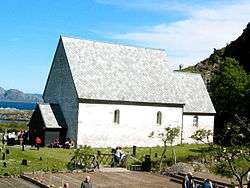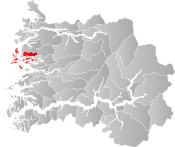Kinn (former municipality)
Kinn is a former municipality in the Sunnfjord district of Sogn og Fjordane county, Norway. The parish of Kinn has existed for centuries and in 1838, the large parish was established as a municipality that existed from then until 1964. The municipality was centered around the island of Kinn where the main Kinn Church is located. The municipality encompassed most of the southern part of the present-day municipality of Kinn (same name, different borders) as well as parts of Askvoll (in the south) and the southwestern part of Bremanger (in the north). Upon its dissolution in 1964, it covered 159 square kilometres (61 sq mi).[1]
Kinn herad | |
|---|---|
 View of the local Kinn Church | |
 Sogn og Fjordane within Norway | |
 Kinn within Sogn og Fjordane | |
| Coordinates: 61°33′59″N 04°45′25″E | |
| Country | Norway |
| County | Sogn og Fjordane |
| District | Sunnfjord |
| Established | 1 Jan 1838 |
| Disestablished | 1 Jan 1964 |
| Administrative centre | Kinn |
| Area | |
| • Total | 159 km2 (61 sq mi) |
| *Area at municipal dissolution. | |
| Time zone | UTC+01:00 (CET) |
| • Summer (DST) | UTC+02:00 (CEST) |
| ISO 3166 code | NO-1437 |
| Created as | Formannskapsdistrikt in 1838 |
| Succeeded by | Flora Municipality in 1964 |
On 1 January 2020, the old Kinn name was brought back into use when the municipalities of Flora, Norway and Vågsøy merged, creating a new Kinn Municipality.[1]
Name
The municipality (and the island) were named after the old Kinn farm (Old Norse: Kinn) since Kinn Church is located there. The name is identical with the word for "cheek", referring to the steep slope of a mountain on the island. Historically, the name was spelled Kind.[2]
History
The parish of Kinn was established as a municipality on 1 January 1838 (see formannskapsdistrikt law). On 3 January 1861, the village of Florø (population: 846) was established as a ladested (port town) and it was therefore separated from the municipality of Kinn to become a municipality of its own. This left 6,531 residents in Kinn. Then on 1 January 1866, the northern district of Kinn on the islands of Bremangerlandet and Frøya and the mainland area surrounding the Gulen Fjord (population: 1,852) was separated from Kinn to form the separate municipality of Bremanger. After the split, Kinn was left with 4,679 inhabitants.
On 1 January 1923, Kinn was split into three separate municipalities:
- Kinn, which included the western islands and the mainland areas surrounding Florø, but not including the port town (population: 2,508)
- Bru, which included the southern islands of Svanøy and Askrova, a small area south of the Førdefjorden, the area around the village of Stavang, and the large valley east of the village of Norddalsfjord (population: 1,560)
- Eikefjord, which included the eastern district around the eastern end of the Eikefjorden (population: 929)
During the 1960s, there were many municipal mergers across Norway due to the work of the Schei Committee. On 1 January 1964, a merger took place which reunited most of the old municipality of Kinn. Before the merger Kinn had a population of 3,567. The new municipality was called Flora, and it included:[3]
- the ladested of Florø (population: 2,040)
- the municipalities of Kinn (population: 3,567) and Eikefjord (population: 919)
- the parts of Bru municipality that were north of the Førdefjorden (population: 1,155)
- the villages of Husefest and Breivik in Bremanger municipality (population: 9)
- the Steindal valley area in Vevring municipality (population: 25)
Government
Municipal council
The municipal council (Heradsstyre) of Kinn was made up of 21 representatives that were elected to four year terms. The party breakdown of the final municipal council was as follows:
| Party Name (in Nynorsk) | Number of representatives | |
|---|---|---|
| Labour Party (Arbeidarpartiet) | 9 | |
| Christian Democratic Party (Kristeleg Folkeparti) | 2 | |
| Liberal Party (Venstre) | 7 | |
| Joint List(s) of Non-Socialist Parties (Borgarlege Felleslister) | 3 | |
| Total number of members: | 21 | |
| Party Name (in Nynorsk) | Number of representatives | |
|---|---|---|
| Labour Party (Arbeidarpartiet) | 9 | |
| Conservative Party (Høgre) | 2 | |
| Christian Democratic Party (Kristeleg Folkeparti) | 1 | |
| Liberal Party (Venstre) | 8 | |
| Local List(s) (Lokale lister) | 1 | |
| Total number of members: | 21 | |
| Party Name (in Nynorsk) | Number of representatives | |
|---|---|---|
| Labour Party (Arbeidarpartiet) | 6 | |
| Conservative Party (Høgre) | 3 | |
| Liberal Party (Venstre) | 7 | |
| Total number of members: | 16 | |
| Party Name (in Nynorsk) | Number of representatives | |
|---|---|---|
| Conservative Party (Høgre) | 3 | |
| Liberal Party (Venstre) | 7 | |
| List of workers, fishermen, and small farmholders (Arbeidarar, fiskarar, småbrukarar liste) | 6 | |
| Total number of members: | 16 | |
| Party Name (in Nynorsk) | Number of representatives | |
|---|---|---|
| Labour Party (Arbeidarpartiet) | 6 | |
| Conservative Party (Høgre) | 4 | |
| Local List(s) (Lokale lister) | 6 | |
| Total number of members: | 16 | |
| Party Name (in Nynorsk) | Number of representatives | |
|---|---|---|
| Labour Party (Arbeidarpartiet) | 5 | |
| Liberal Party (Venstre) | 5 | |
| Joint List(s) of Non-Socialist Parties (Borgarlege Felleslister) | 6 | |
| Total number of members: | 16 | |
Notable residents
- Hans Jensen Blom, the vicar of Kinn Church and member of the Parliament of Norway
- Mathias Sigwardt Greve, a physician who briefly worked in Kinn
- Ivar Lykke Falch Lind, the former mayor and bailiff of Kinn
- Michael Sars, the vicar of Kinn Church from 1831–1838
- Georg Ossian Sars, a marine biologist who discovered that cod fish eggs are pelagic
References
- Store norske leksikon. "Kinn. – kommune" (in Norwegian). Archived from the original on 2012-09-29. Retrieved 2013-11-06.
- Rygh, Oluf (1919). Norske gaardnavne: Nordre Bergenhus amt (in Norwegian) (12 ed.). Kristiania, Norge: W. C. Fabritius & sønners bogtrikkeri. p. 359.
- Jukvam, Dag (1999). "Historisk oversikt over endringer i kommune- og fylkesinndelingen" (PDF) (in Norwegian). Statistisk sentralbyrå. Cite journal requires
|journal=(help) - "Kommunevalgene og Ordførervalgene 1959" (PDF) (in Norwegian). Oslo: Statistisk sentralbyrå. 1960. Retrieved 2020-02-16.
- "Kommunevalgene og Ordførervalgene 1955" (PDF) (in Norwegian). Oslo: Statistisk sentralbyrå. 1957. Retrieved 2020-02-16.
- "Kommunevalgene og Ordførervalgene 1951" (PDF) (in Norwegian). Oslo: Statistisk sentralbyrå. 1952. Retrieved 2020-02-16.
- "Kommunevalgene og Ordførervalgene 1947" (PDF) (in Norwegian). Oslo: Statistisk sentralbyrå. 1948. Retrieved 2020-02-16.
- "Kommunevalgene og Ordførervalgene 1945" (PDF) (in Norwegian). Oslo: Statistisk sentralbyrå. 1947. Retrieved 2020-02-16.
- "Kommunevalgene og Ordførervalgene 1937" (PDF) (in Norwegian). Oslo: Statistisk sentralbyrå. 1938. Retrieved 2020-05-11.
External links

- Weather information for Kinn (in Norwegian)

